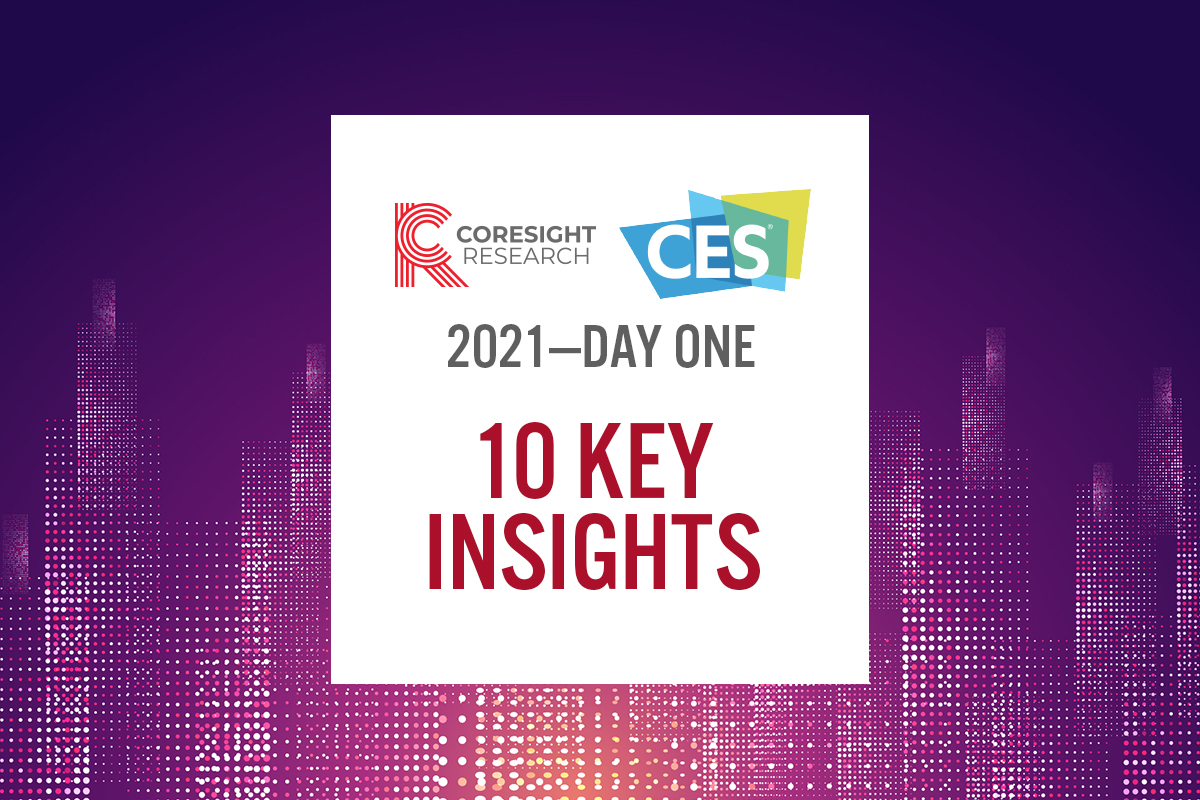
Nitheesh NH
CES 2021, an event held by the Consumer Technology Association (CTA), is taking place on January 11–14 and is a virtual event for the first time. Key tech trends at this year’s CES include digital health, robotics and drones, 5G connectivity, digital transformation, vehicle technology and smart cities.
The Coresight Research team will present takeaways from the three-day event in three reports. In this report, we offer 10 key insights from day one.
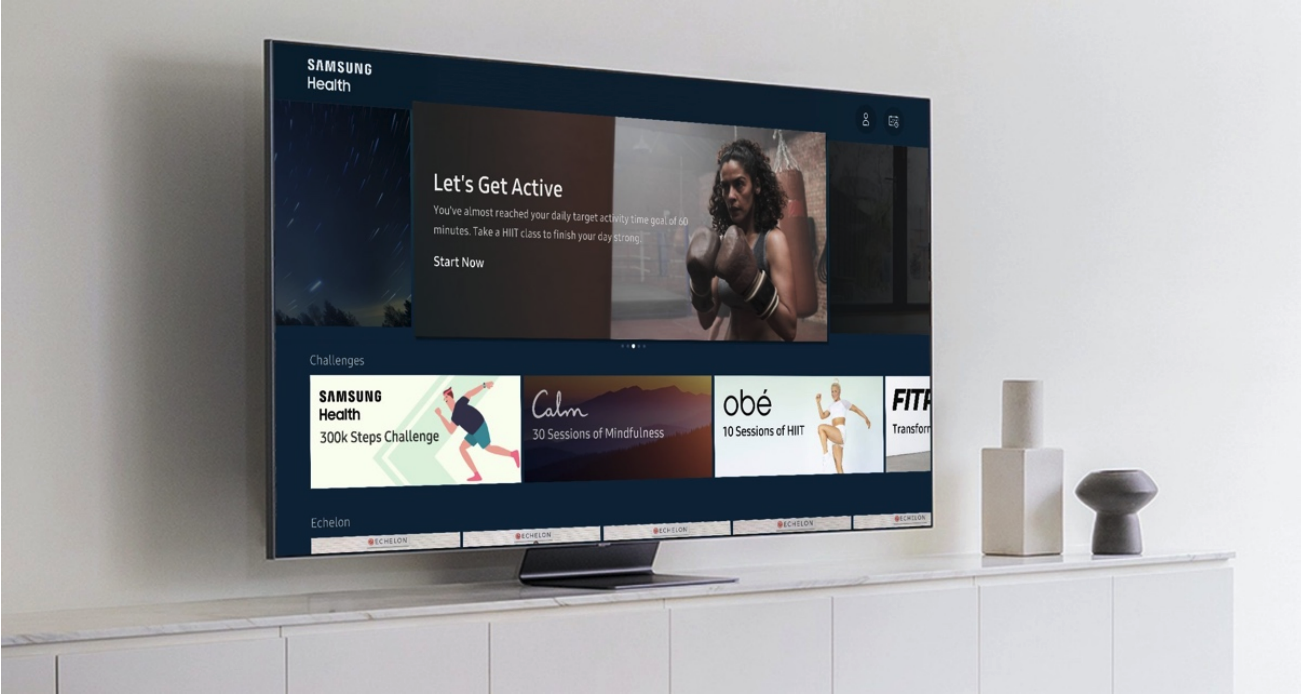 Samsung Health screen
Samsung Health screen
Source: Samsung[/caption] 2. A Focus on Health and Home Cleanliness Gives Rise to New Gadgets With the ongoing pandemic having heightened consumer awareness of health, several consumer electronics companies at CES announced new products to enhance home cleanliness: LG announced new products featuring “air-management technology,” including portable air purifiers and purifiers with new HEPA filters. In addition, the brand’s washing machines have a new allergen-cycle feature, which LG claims removes 95% of household allergens. LG also announced a robot that uses UV light to sanitize hotel rooms. [caption id="attachment_121653" align="aligncenter" width="520"] Robot for sanitizing hotel rooms
Robot for sanitizing hotel rooms
Source: LG[/caption] Samsung demonstrated an artificial intelligence (AI)-powered robotic vacuum cleaner that uses sensors, including Lidar, to clean around toys, pets and other items. [caption id="attachment_121654" align="aligncenter" width="700"]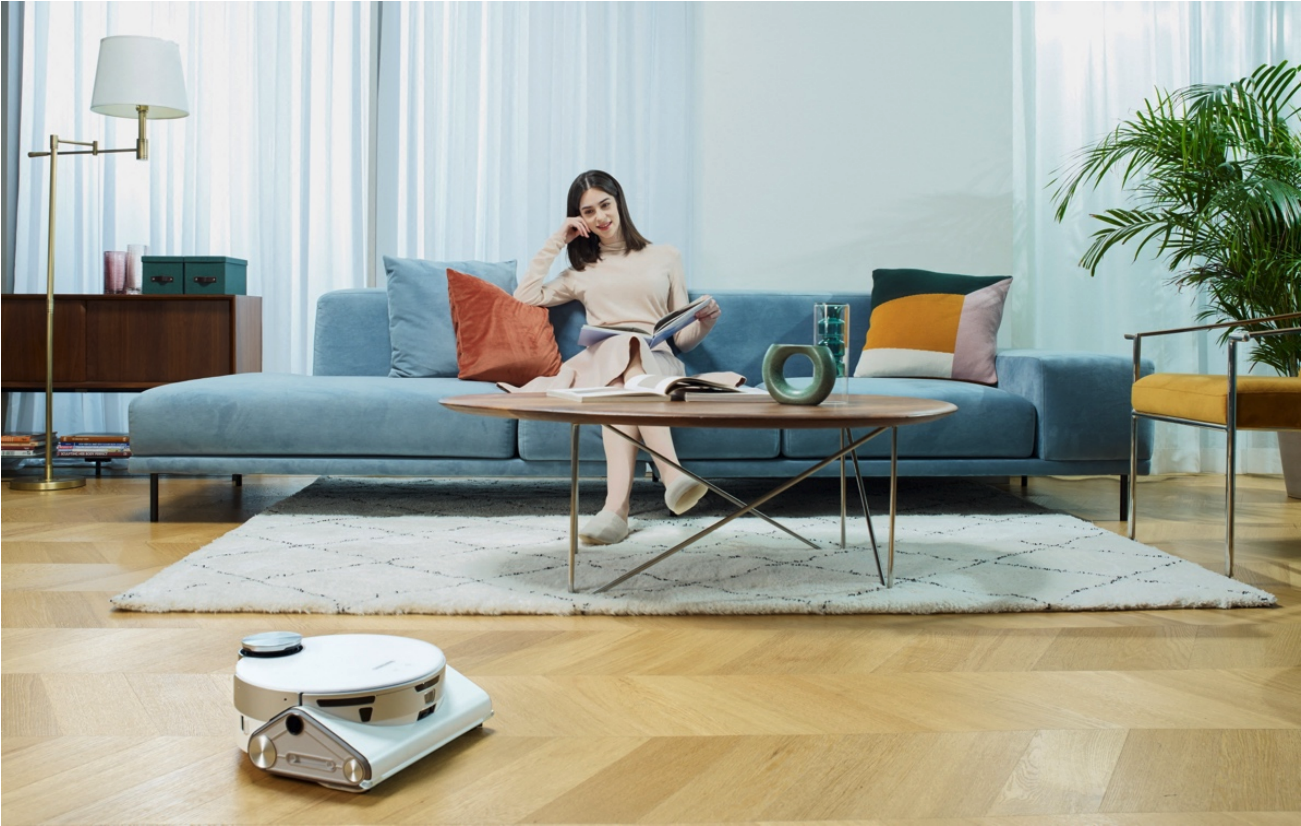 JetBot 90+ AI-powered robotic vacuum
JetBot 90+ AI-powered robotic vacuum
Source: Samsung[/caption] 3. New TVs Use Micro-/Mini-LED Backlighting for Greater Brightness and Contrast Recent generations of LCD (liquid-crystal display) and OLED (organic light-emitting diode displays) TVs use micro-LEDs that can selectively illuminate regions at the back of the screen to provide better brightness and contrast for a higher-quality picture, compared to a matrix of LEDs that could only be on or off in prior generations. LG announced several TVs with OLED, including a new line with mini-LED technology, in addition to a computer monitor incorporating an OLED display. [caption id="attachment_121655" align="aligncenter" width="580"]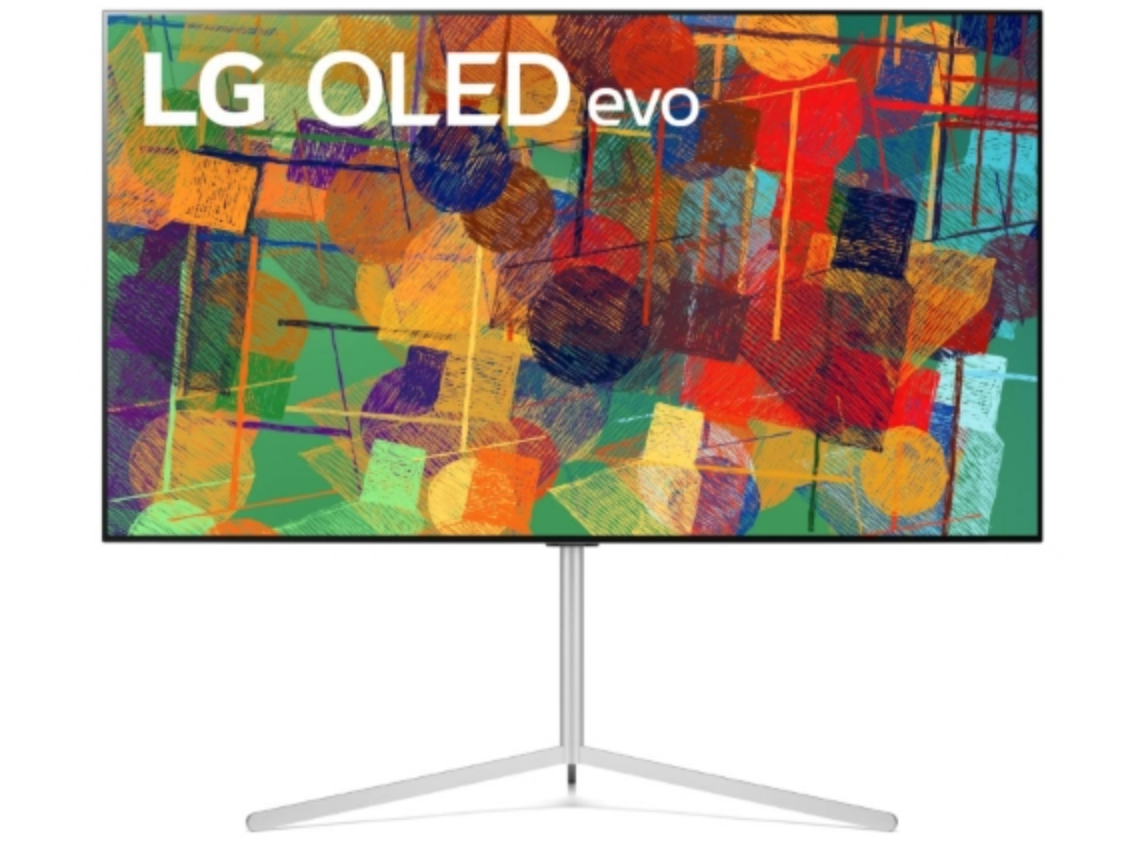 New OLED TV with mini-LED backlighting
New OLED TV with mini-LED backlighting
Source: LG[/caption] Samsung announced a 110-inch TV with micro-LED backlighting that offers the ability to view four separate video streams at one time—meaning that viewers can watch multiple sporting events at the same time, for example. Samsung also announced new TVs in various form factors, including a 4K QLED (quantum-dot light-emitting diode display) outdoor TV. 4. Consumer Electronics Products and Packaging Are Being Upcycled for Sustainability Samsung made several announcements with regard to sustainability: Electronics packaging repurposed as furniture
Electronics packaging repurposed as furniture
Source: Samsung[/caption] 5. Technology Continues To Improve Everyday Health and Wellness and Doctor Care There exist many devices and apps that monitor health and wellness metrics, including water and calorie intake. Day one of CES 2021 saw new devices in a variety of form factors, from the Oura Ring, which monitors sleep and activity, to the BioIntelliSense BioButton, an FDA-approved device that monitors vital signs. Figure 1 shows a forecast by the CTA of US connected health-monitoring device sales. Figure 1. US Connected Health-Monitoring Device Market (USD Mil.) [caption id="attachment_121657" align="aligncenter" width="700"]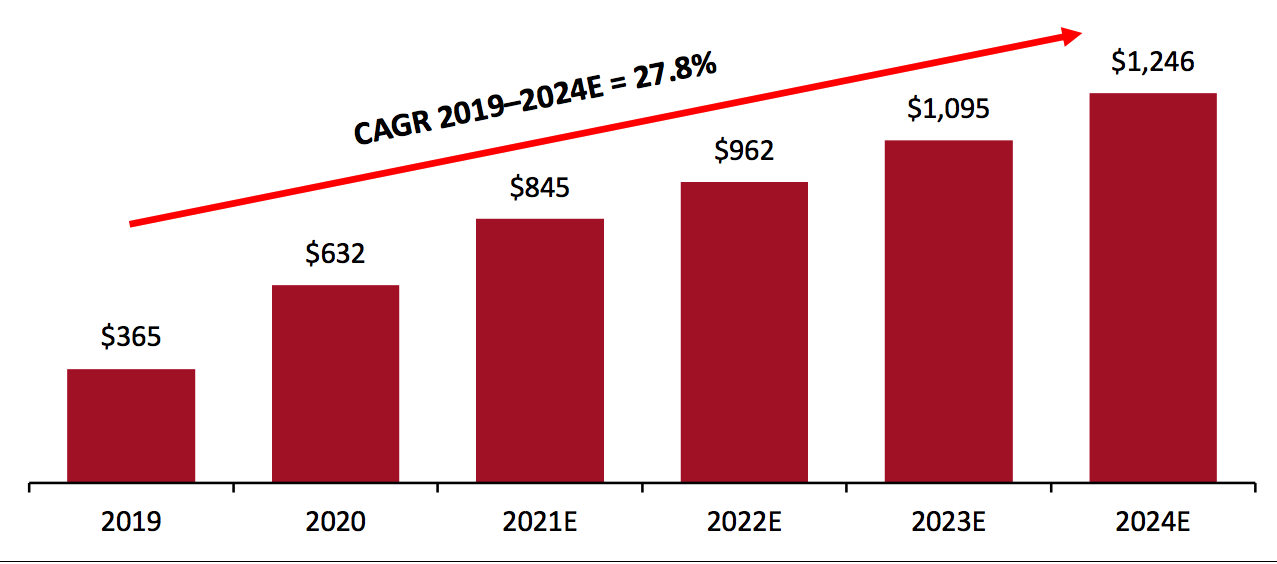 Source: The CTA US Consumer Technology Five-Year Industry Forecast, 2019–2024[/caption]
Other applications of technology within healthcare include robots to maintain hygiene and in triage; the use of AI in diagnosis; and the use of XR (extended reality) in medicine—for example, in remote surgery.
6. Digital Transformation in the Fitness, Education and Legal Sectors Is Accelerating
Steve Koenig, VP of Research at the CTA, launched his remarks on the topic of digital transformation with a quote from Microsoft CEO Satya Nadella, commenting that, “We’ve seen two years’ worth of digital transformation in two months” as the Covid-19 outbreak prompted enterprises to accelerate their cloud plans while focusing on security.
Three areas in particular are being transformed:
Source: The CTA US Consumer Technology Five-Year Industry Forecast, 2019–2024[/caption]
Other applications of technology within healthcare include robots to maintain hygiene and in triage; the use of AI in diagnosis; and the use of XR (extended reality) in medicine—for example, in remote surgery.
6. Digital Transformation in the Fitness, Education and Legal Sectors Is Accelerating
Steve Koenig, VP of Research at the CTA, launched his remarks on the topic of digital transformation with a quote from Microsoft CEO Satya Nadella, commenting that, “We’ve seen two years’ worth of digital transformation in two months” as the Covid-19 outbreak prompted enterprises to accelerate their cloud plans while focusing on security.
Three areas in particular are being transformed:
 Autonomous vehicle testing in Detroit
Autonomous vehicle testing in Detroit
Source: Intel’s Mobileye[/caption] 10. 5G Is the Innovation Platform That Makes Other Innovations Possible Verizon CEO Hans Vestberg kicked off his keynote address by commenting that, due to the presence of 5G, many technologies expected in the future have now become part of the present, such as streaming, remote work and mobile payments. 5G technology is able to spark many “remember when?” moments as the new benefits from the technology become part of our everyday lives. Vestberg delivered a CES keynote address on 5G in 2019. At that time, he outlined the eight currencies of 5G (in the future). These have since been accelerated to become part of the present. The currencies are as follows:
CES Day One: 10 Key Insights
The first day of CES 2021 focused on new product announcements by major global consumer-electronics companies, across health and wellness, home cleanliness and entertainment, and more. The event proper was kicked off with a keynote address by Hans Vestberg, CEO of telecommunications company Verizon, in the evening. 1. Consumer Electronics Devices Are Evolving To Reflect That Consumers Are Spending More Time at Home With many consumers working and spending more time at home due to the Covid-19 pandemic, consumer electronics devices are evolving to support consumers in being healthier, more comfortable and more productive at home. Samsung introduced its new Smart Trainer feature on the Health platform for its 2021 TV models. The feature transforms the home into a personal gym and tracks and analyzes posture in real time, like a personal trainer. It also provides feedback on form, counts reps and estimates calories burned during exercise. The feature can be voice controlled. [caption id="attachment_121652" align="aligncenter" width="700"] Samsung Health screen
Samsung Health screenSource: Samsung[/caption] 2. A Focus on Health and Home Cleanliness Gives Rise to New Gadgets With the ongoing pandemic having heightened consumer awareness of health, several consumer electronics companies at CES announced new products to enhance home cleanliness: LG announced new products featuring “air-management technology,” including portable air purifiers and purifiers with new HEPA filters. In addition, the brand’s washing machines have a new allergen-cycle feature, which LG claims removes 95% of household allergens. LG also announced a robot that uses UV light to sanitize hotel rooms. [caption id="attachment_121653" align="aligncenter" width="520"]
 Robot for sanitizing hotel rooms
Robot for sanitizing hotel roomsSource: LG[/caption] Samsung demonstrated an artificial intelligence (AI)-powered robotic vacuum cleaner that uses sensors, including Lidar, to clean around toys, pets and other items. [caption id="attachment_121654" align="aligncenter" width="700"]
 JetBot 90+ AI-powered robotic vacuum
JetBot 90+ AI-powered robotic vacuumSource: Samsung[/caption] 3. New TVs Use Micro-/Mini-LED Backlighting for Greater Brightness and Contrast Recent generations of LCD (liquid-crystal display) and OLED (organic light-emitting diode displays) TVs use micro-LEDs that can selectively illuminate regions at the back of the screen to provide better brightness and contrast for a higher-quality picture, compared to a matrix of LEDs that could only be on or off in prior generations. LG announced several TVs with OLED, including a new line with mini-LED technology, in addition to a computer monitor incorporating an OLED display. [caption id="attachment_121655" align="aligncenter" width="580"]
 New OLED TV with mini-LED backlighting
New OLED TV with mini-LED backlightingSource: LG[/caption] Samsung announced a 110-inch TV with micro-LED backlighting that offers the ability to view four separate video streams at one time—meaning that viewers can watch multiple sporting events at the same time, for example. Samsung also announced new TVs in various form factors, including a 4K QLED (quantum-dot light-emitting diode display) outdoor TV. 4. Consumer Electronics Products and Packaging Are Being Upcycled for Sustainability Samsung made several announcements with regard to sustainability:
- The company announced an update to its Galaxy Upcycling initiative. Galaxy Upcycling at Home aims to reimagine older Galaxy phones as new devices as part of a consumer’s connected home—for example, used as a childcare tool that sends alerts to parents if a baby is crying.
- Samsung’s new Solar Cell Remote Control, which is partially made with recycled plastic, can be charged via solar or indoor lighting, thus reducing battery waste.
- Samsung has added eco-packaging to its 2021 QLED UHD (ultra-high definition) TV, monitor and audio products. The products’ packaging can be repurposed as furniture.
 Electronics packaging repurposed as furniture
Electronics packaging repurposed as furnitureSource: Samsung[/caption] 5. Technology Continues To Improve Everyday Health and Wellness and Doctor Care There exist many devices and apps that monitor health and wellness metrics, including water and calorie intake. Day one of CES 2021 saw new devices in a variety of form factors, from the Oura Ring, which monitors sleep and activity, to the BioIntelliSense BioButton, an FDA-approved device that monitors vital signs. Figure 1 shows a forecast by the CTA of US connected health-monitoring device sales. Figure 1. US Connected Health-Monitoring Device Market (USD Mil.) [caption id="attachment_121657" align="aligncenter" width="700"]
 Source: The CTA US Consumer Technology Five-Year Industry Forecast, 2019–2024[/caption]
Other applications of technology within healthcare include robots to maintain hygiene and in triage; the use of AI in diagnosis; and the use of XR (extended reality) in medicine—for example, in remote surgery.
6. Digital Transformation in the Fitness, Education and Legal Sectors Is Accelerating
Steve Koenig, VP of Research at the CTA, launched his remarks on the topic of digital transformation with a quote from Microsoft CEO Satya Nadella, commenting that, “We’ve seen two years’ worth of digital transformation in two months” as the Covid-19 outbreak prompted enterprises to accelerate their cloud plans while focusing on security.
Three areas in particular are being transformed:
Source: The CTA US Consumer Technology Five-Year Industry Forecast, 2019–2024[/caption]
Other applications of technology within healthcare include robots to maintain hygiene and in triage; the use of AI in diagnosis; and the use of XR (extended reality) in medicine—for example, in remote surgery.
6. Digital Transformation in the Fitness, Education and Legal Sectors Is Accelerating
Steve Koenig, VP of Research at the CTA, launched his remarks on the topic of digital transformation with a quote from Microsoft CEO Satya Nadella, commenting that, “We’ve seen two years’ worth of digital transformation in two months” as the Covid-19 outbreak prompted enterprises to accelerate their cloud plans while focusing on security.
Three areas in particular are being transformed:
- Fitness—Consumer spending on at-home digital fitness products has grown dramatically (the CTA estimates 30–35% versus pre-Covid levels), and many gyms started to offer online fitness classes.
- Education—In addition to at-home school classes, the UK’s LendED platform enables students to share learning materials.
- Legal—Court hearings are being held virtually, and proceedings are now hosted on virtual platforms.
- Robots have come to our assistance in a major way during the padnemic, across the following areas:
- Cleaning—Robots now clean and disinfect floors and surfaces in warehouses, retail stores, hotel room and hospitals.
- Delivery—Autonomous vehicles and drones have been used to deliver groceries, medicine and other items to locked-down or remote locations.
- Food preparation—Robots can prepare, cook and recycle food products including coffee.
- Health—Robots can monitor temperatures of employees entering offices and other buildings.
- Inventory—Robots from Bossa Nova and Zebra scan store shelves to count inventory and ensure it is in the correct location.
- Monitoring—Robots can monitor individuals’ health and enable communication with people at other locations, e.g., telepresence robots.
- Autonomous Vehicle Fleets/Mobility as a Service (MaaS)—Fleets of autonomous vehicles can be used to provide transportation as a service, freeing consumers from having to own or drive their own cars. The Ford Motor Company has established a subsidiary to develop this concept.
- C-V2X Connectivity—This stands for cellular-vehicle-to-everything and represents the ability to connect many types of vehicles to the Internet through cellular wireless networks. The ability of 5G wireless networks to connect to millions of vehicles and other objects enables the connection of virtually every vehicle to a smart city network.
- Electrification—The runaway success of Tesla, combined with major vehicle manufacturers such as General Motors (and even others such as Apple, as is rumored) leveraging their futures on electric vehicles, underscores the importance and emergence of intelligent, electrical vehicles for safety and sustainability.
 Autonomous vehicle testing in Detroit
Autonomous vehicle testing in DetroitSource: Intel’s Mobileye[/caption] 10. 5G Is the Innovation Platform That Makes Other Innovations Possible Verizon CEO Hans Vestberg kicked off his keynote address by commenting that, due to the presence of 5G, many technologies expected in the future have now become part of the present, such as streaming, remote work and mobile payments. 5G technology is able to spark many “remember when?” moments as the new benefits from the technology become part of our everyday lives. Vestberg delivered a CES keynote address on 5G in 2019. At that time, he outlined the eight currencies of 5G (in the future). These have since been accelerated to become part of the present. The currencies are as follows:
- Throughput—5G offers 10x the download speed of 4G.
- Service deployment—It is faster and easier to deploy new services with 5G compared to the previous-generation network.
- Mobility—The networks can connect to high-speed vehicles that are traveling up to 500km/h.
- Connected devices—5G can support up to 1 million connected devices per square kilometer, ultimately 10–100 times the number of devices that 4G can connect.
- Energy efficiency— Vestberg highlighted that 5G networks and devices consume only 10% of the energy consumed by 4G.
- Data volume—The 5G standard supports enormous data density, which supports fast speeds in high-density areas such as airports, stadiums and urban areas.
- Latency—It is much quicker to connect to the network, enabling advanced applications such as autonomous and virtual reality, autonomous driving, computer vision and robotics.
- Reliability—The experience gained in operating 4G networks will lead to higher reliability in 5G.
- 5G enables mobile-edge computing, as computing power moves from the center to the edge of the network.
- 5G networks can be segmented to serve different communities, with users able to create their own personal networks.